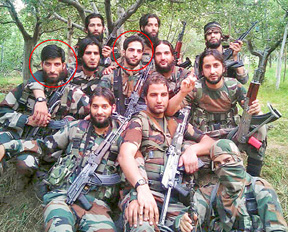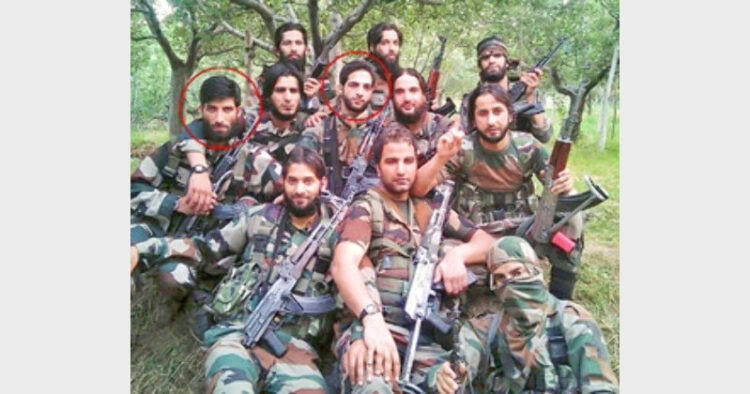 Why is only southern part of Jammu and Kashmir known as the breeding ground of terrorism with increased number of encounters?
Why is only southern part of Jammu and Kashmir known as the breeding ground of terrorism with increased number of encounters?
Brig Anil Gupta
Recently South Kashmir has been in news quite often. It has witnessed a number of terror acts and encounters in the past six months. In a recent encounter Burhan Wani, terrorist and regional commander of Hizbul Mujahideen (HM), was gunned down by the security forces (SFs) along with his two colleagues. Burhan Wani had 20 criminal cases registered against him and carried an award of 10 lakh on his head. His killing led to a severe backlash resulting in 36 deaths, numerous injured, loot, arson, burning of public and private property, kidnapping of policemen and temporary suspension of the ongoing Amarnath Yatra.
The situation is still tense and will continue to simmer for some time. One question must be haunting the minds of many readers as to why all this is happening in South Kashmir only. The question is justified and needs an analysis. Burhan Wani is credited with unleashing a wave of ‘New Militancy’ characterised by increase in number of local militants, extensive use of social media to extend the outreach of militancy with South Kashmir as its base, involvement of the locals in militancy characterised by huge outflow to attend funerals of terrorists and hampering the operations of SFs and penchant for imaginary ‘azadi’ particularly among the youth.
The aim of this article is not to discuss Burhan Wani, who like any other terrorist commander was operating based on instructions received from across the LOC from mentors in Pakistan to support the Pak sponsored proxy war as an extension of Jihadi Terror. The aim is to analyse the advantages South Kashmir affords for sustaining the militancy because of which it has emerged as hub of ‘New Militancy’ in Kashmir, not to be confused with home-grown militancy. ‘New Militancy’ is part of a well- planned strategy unleashed by Pak’s Inter- Services Intelligence (ISI) to keep the pot boiling in Kashmir.
The major advantage South Kashmir enjoys over the other parts of the Valley is favourable terrain. The terrain is characterised by the Pir Panjal ranges and its various off-shoots, thick jungles, river Jhelum flowing from South to North running almost parallel to the National Highway (NH), densely populated with large built up areas and towns, a well-connected internal network of roads. South Kashmir also has the best surface connectivity with rest of the state across Pir Panjal. NH 44 connecting Jammu with Srinagar through the Banihal tunnel, the Mughal road connecting Poonch – Rajauri via Pir Ki Gali, Road Kishtwar-Anantnag via Sinthan Top and broad gauge railway connecting Banihal-Baramullah. The terrain in South Kashmir is being exploited by the terrorists to their advantage. With the availability of additional avenues of ingress/egress the infiltration pattern has changed. Gulmarg-Poonch-Mughal Road-South Kashmir is becoming a favourite route for the reason that it provides a free run to the terrorists across the Mughal Road. Mughal Road is being extensively used for smuggling of arms and ammunition as well. Lack of the presence of SFs on the Mughal Road provides the terrorists with a free run. It is also being used for spreading the arc of radicalisation and Hurriyat ideology South of Pir Panjal particularly in Poonch-Rajauri belt.
There is an urgent need to establish SFs camps on the Mughal Road to choke the free movement of Salafi preachers, Hurriyat leaders, arms and ammunition and terrorists. Another avenue available to terrorists for entry/exit is the road Anantnag-Kishtwar. This also enables the terrorists to move into South Kashmir using the International Border (IB) route. Any move to make this road as well as Mughal Road as all-weather by tunnelling needs to be strongly resisted because it will facilitate the move of terrorists into and out of South Kashmir throughout the year making it further attractive to the terrorists. Another boon to the terrorists has been the rail. It has facilitated their move between North and South Kashmir. Whenever, SFs exert operational pressure on terrorists in North Kashmir they melt into their hideouts in South Kashmir which also provides the terrorists three escape routes to run away South of Pir Panjal. Forests and jungles are in plenty providing suitable hideouts.
A terrorist/militant without local support is like a fish out of water. Hence popular support is essential for any militancy to survive. South Kashmir is densely populated with a mix of rural and urban population that is friendly to their cause. Anantnag town with its narrow lanes and vast spread is ideal for urban insurgency.
Traditionally South Kashmir has been a home of large Jamaat-i-Islami cadre with pro-separatist mind-set and sympathetic to the HM. The mushrooming of petro-dollar financed Salafi mosques and Madrasas and emergence of Jamiat Ahlehadith Jammu and Kashmir on the scene has further radicalised the local population hardening their support to anti-national and pro-separatist ideology duly backed by Pakistan and ISI. South Kashmir, adobe of Muftis, has been their traditional stronghold and political citadel hence an eye-sore for the rival valley-centric political parties. In addition to various political machinations these parties have also been clandestinely hobnobbing with the ultras to let the Muftis down and fish in troubled waters. With its proximity to Srinagar, a major educational hub, the literacy rate in South Kashmir is also quite high. This has led to creation of a vast reservoir of educated, tech-savvy, dis-enchanted unemployed youth who see no ray of hope with limited employment opportunities, feel politically disempowered, live with a perceived insecurity of losing special status and being overpowered by outsiders; ideal material for falling prey to ISI sponsored propaganda and being lured into militancy. This segment was exploited by Burhan Wani through social media. Proximity to Srinagar also ensures the presence of a large number of media men; local and national. Media provides them oxygen, vital for survival.
The faulty Rehabilitation Policy launched by the previous government in November 2010 is another contributory factor. A large number of these surrendered ex-militants who returned to the state via the illegal Nepal route settled with their families in different parts of South Kashmir particularly in Tral, Kulgam and Anantnag areas. They were required to be screened by intelligence agencies after arrival and put through ‘De-radicalisation’ process in specially established camps. None of it happened. Instead they were allowed to merge with others freely. Many of these terrorists returned with 3 to 4 children. No DNA test was carried out to ascertain their parenthood. Keeping in view the ISI’s track record likelihood of these young children being a product of radical madrassas (religious seminaries) and smuggled into India cannot be ruled out. God forbid, if it turns out to be true, the consequences will be unimaginable. Many of these ex-militants, including those released from jails because of weak prosecution, have been recycled into active militancy thus leading to the increase in the number of local militants; another dangerous trend contributing to South Kashmir’s emergence as hub of ‘New Militancy’.
(The author is a Jammu based political commentator, columnist, security and strategic analyst)














Comments